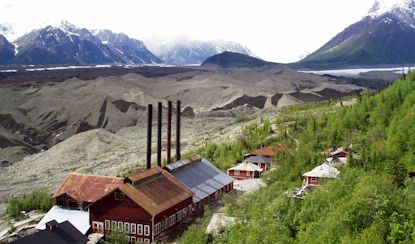 |
 | |
  | |
|
|
|
|
Wrangell-St. Elias National Park & Preserve
Kennecott
|
|
|
|
|
| |
 |
|
In June of 1998, the National Park Service acquired many of the significant buildings and lands of the historic mining town of Kennecott. Designated as a National Historic Landmark since 1978, Kennecott is considered the best remaining example of early 20th Century copper mining.
|
A Link To History The Kennecott mill town and mines are an extraordinary relic from America's past. The impressive structures and artifacts that remain, represent an ambitious time of exploration, discovery, and technological innovation. They tell stories of westward expansion, World War I politics and economy, the lives of men, women, and children who lived there, and the rise of a multinational corporation. Each link in the historical chain connects to another until we realize that this remote, Alaska mining venture was intricately connected to the world around it.

|
| NPS T. VandenBerg |
| Kennecott Power Plant alongside the Kennicott Glacier. |
|
 |
Kennecott Photo Gallery (8 Photos)
Photos of Kennecott Mines National Historic Landmark
|
The Kennecott Mines National Historic Landmark includes the land and mining claims that formed the foundation for the Kennecott Copper Corporation, later the Kennecott Minerals Company. The operation had two components: the mines where ore was extracted from the mountains, and the mill town where the ore was processed. From 1911 to 1938, nearly $200 million worth of copper was processed. At the peak of operation, approximately 300 people worked in the mill town and 200-300 in the mines. Kennecott was a self-contained company town that included a hospital, general store, school, skating rink, tennis court, recreation hall, and dairy.
|
By the late 1920s, the supply of high-grade ore was diminishing, and Kennecott Copper Corporation was diversifying into other North American and Chilean mines. Declining profits and increasing costs of railroad repairs led to the eventual closure of the Kennecott operation by 1938. By that time, the corporation was well on the way to becoming a multinational giant.
|
|
Stabilizing A Landmark
Many of the buildings in Kennecott have been abandoned for sixty years. Some are in need of immediate stabilization to keep them standing, while some have deteriorated beyond the point of saving.
The National Park Service, along with the local community and , has engaged in an ongoing planning effort to identify buildings that will be stabilized or rehabilitated, and those that will not receive any attention at all. The goal is to protect the historic integrity of the mill town so that future generations will also be able to explore Kennecott.
A few buildings will be rehabilitated for modern use. The Recreation Hall was completed in 2004. It is used for educational programs and community events. The Store and Post Office will serve as the future visitor center. Several other buildings are currently receiving repairs to roofs, foundations, and walls. Throughout the mill town you will observe lots of activity throughout the summer.
The stabilization work in Kennecott is expected to take many years. Through the hard work of many dedicated individuals, a unique piece of American history will have been preserved.
|
How Did It All Work?
Detailed engineering drawings of Kennecott
from the Historic American Engineering Record
|
|
12 minute video highlighting the construction and operation of the mines at Kennecott.
Learn about the various processes that were involved in obtaining the rich copper ore, concentrating it, and shipping it out of the Alaskan wilderness.
|
|  |  |
|
|

The Kennecott Story
Historical Guide to Kennecott
more... | | 
Kennecott Mill Town Map
Map of all existing buildings
more... | | 
How Do I Get To Kennecott?
Drive, Ride, or Fly
more... | | 
McCarthy Road Guide
Map and travel info
more... | |
|
|
|
|
|
|
|
 |
|
Did You Know?
The fishwheel, today a common means of harvesting salmon on Alaska’s Copper River, first appeared in North America in Eastern North Carolina, where it was used to catch shad on the Roanoke and Pee Dee Rivers.
|
|
|
|
Last Updated: October 10, 2007 at 13:26 EST |






